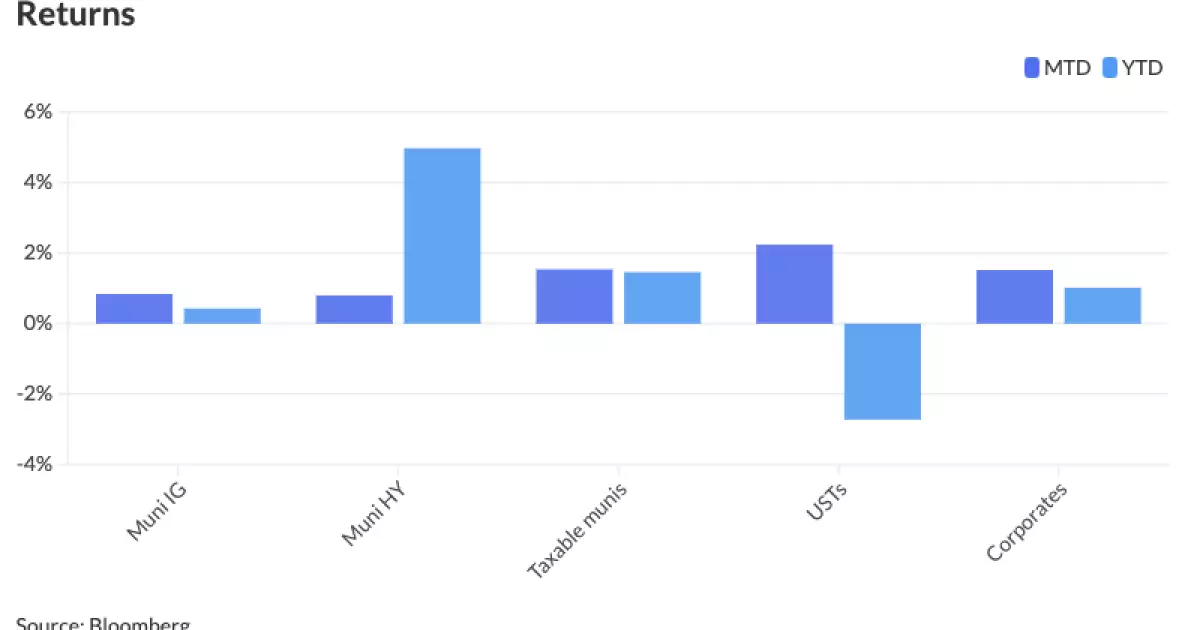The municipal bond market has exhibited remarkable stability recently, with little fluctuation in yields over the past week. This steadiness comes against a backdrop of strengthening U.S. Treasuries and a mixed performance in equity markets, indicating a cautious investor sentiment. Despite a slight rally this month, characterized by a drop in yields averaging 15 basis points along the curve, municipal bonds remain inherently more expensive than their Treasury counterparts, as observed by Jason Wong, Vice President at AmeriVet Securities. However, the current situation does signal opportunities for investors looking to navigate the complexities of the market.
The latest figures show that the 10-year municipal bond yield fell by 2.2 basis points to 2.78% as of last Friday; however, this still positions it considerably higher than the start of the year when yields hovered around 2.28%. Such trends illustrate that even though yields have declined in the short-term, the broader year-to-date perspective shows a notable increase, complicating investment decisions for potential buyers.
The assessment of municipal bonds relative to U.S. Treasuries reveals compelling insights. The 10-year muni-to-Treasury ratio currently stands at approximately 58.48%, significantly weaker than the historical average of around 86.50%. Such discrepancies indicate that while municipal bonds may appear attractive during periods of falling yields, they are still lagging behind Treasuries in terms of value. This mispricing could either present an attractive entry point or pose risks depending on future movements in interest rates and demand dynamics.
In examining the two-year to 30-year ranges, ratios reflected varying levels of appeal, with figures showing the two-year at 65%, three-year at 66%, and the five-year at 68%. Maintaining a close watch on these ratios will be essential as investment strategies evolve and future Federal Reserve actions unfold, influencing both the attractiveness of munis and their relationship to Treasuries.
One of the pivotal drivers shaping the current municipal market dynamics is the anticipated policy direction from the Federal Reserve. The upcoming Federal Open Market Committee (FOMC) meeting is expected to offer crucial insights, particularly following recent indicators suggesting that inflation is easing. Industry analysts, including Wong, predict that the Fed may signal potential rate cuts as early as September. Such a pivot towards accommodative monetary policy could reinvigorate the municipal market, enticing issuers back into the space – a move that would significantly alter the current landscape for both investors and borrowers.
The ramifications of a rate cut would be multifaceted, but one potential outcome could lead to a tightening of muni-to-Treasury ratios back toward early-year levels. For investors, this could create new opportunities for new issuances, particularly as historical patterns suggest that favorable monetary conditions typically correlate with increased activity in the municipal bond arena.
As we observe market developments, a notable slowdown in primary issuances has been recorded, with current expectations at around $6.6 billion this week as market participants await several key indicators. Noteworthy deals include the $1.106 billion general obligation bond issuance for New York City, reflecting the continuing demand for well-rated municipal issuances despite the tempered environment.
Additionally, various other transactions are lined up, including significant bond issuances by the Port of Seattle and the Port of Portland. While these deals highlight active participation in the market, they also emphasize the importance of maintaining a balanced approach amid varying investor sentiments.
The behavior of investors in the secondary market also warrants attention. Recent evaluations by J.P. Morgan reveal only a marginal increase in customer buying activity, even as demand remains concentrated in longer-duration bonds. This suggests that despite some appetite for new issues, investors are also adopting a cautious stance, potentially seeking more attractive entry points as conditions evolve.
Furthermore, inflows of $866 million into long-term funds indicate a resilient demand for municipal bonds despite the challenges presented by elevated selling activity. The competitive environment within the market, characterized by elevated selling pressures, signals a shift in investor strategies as they navigate the complex dynamics at play.
As the municipal bond market navigates the upcoming months, several trends will be imperative for investors to monitor. The Federal Reserve’s policy changes will undoubtedly have repercussions, influencing not only yield movements but also shaping the broader market sentiment. Investors should remain vigilant and flexible, ready to adapt their strategies as new opportunities emerge.
While the current market environment poses challenges, it is also rich with potential for those equipped with strategic insights and foresight. Keeping a finger on the pulse of federal policy developments, market ratios, and issuance trends will be essential for making informed investment decisions in the municipal bond landscape.

